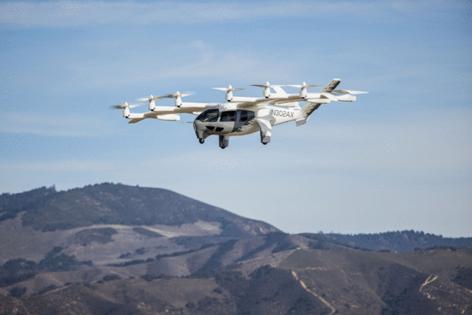As air taxi services make progress in US, no timeline set for liftoff over LA traffic
Published in Science & Technology News
LOS ANGELES — When the idea of electric air taxis emerged, Los Angeles was vying to be one of the first cities that would utilize the technology to help people avoid its infamous bumper-to-bumper traffic. Some city transportation officials expected the flying vehicles to be operational by the 2028 Olympics.
But as air taxi companies have taken further steps toward a launch in other cities,such as Chicago, L.A.'s ambitions to open skyways all over the city have chilled.
Urban Movement Labs, a nonprofit started under former Mayor Eric Garcetti to focus on transit technology, created a primer in 2022 for how cities could incorporate air mobility, including taxi services. But after a merger with Los Angeles Cleantech Incubator, board member Francis Pollara said it's no longer prioritizing the technology.
"We were heavily involved in supporting Archer and the coalition of other air taxis services," Pollaro said about UML's involvement. "That work will not be continued as part of the merger."
The Los Angeles Department of Transportation, City Planning office and the mayor's office were part of the initial Advanced Air Mobility partnership with UML to think about how the technology could integrate into the city. But none of the agencies answered questions about when Angelenos could expect to see air taxi services here.
"As with any new technology, the city is working with industry and our departments, and our priority is keeping Angelenos safe," press secretary Clara Karger said.
The pitch of the air taxi boosters is the notion of gliding speedily over L.A.'s traffic-choked streets: a 60- to 90-minute car ride could take about 10 to 20 minutes in a drone-like vehicle from one so-called vertiport to another.
In order to launch in Los Angeles, an air craft taxi service needs clearance from multiple jurisdictions including the Federal Aviation Administration, which largely oversees airspace, operations and air crafts, and local and state agencies that set their own rules when it comes to regulations and infrastructure, including permits and design plans for take-off and landing zones. While the FAA has continued to greenlight progress for air taxi operations, less movement has been made at the local and state level.
Clint Harper, a community advocate in the advanced air mobility industry, said that licensing requirements in California are "robust" compared to other states and any air taxi service "may be subject to more stringent state oversight" before operations begin.
The FAA cleared Santa Clara-based electric air taxi company Archer earlier this month to operate its air crafts commercially ahead of an official public launch possibly in Newark or Chicago, which the company said could be as early as 2025.
...continued
©2024 Los Angeles Times. Visit at latimes.com. Distributed by Tribune Content Agency, LLC.







Comments